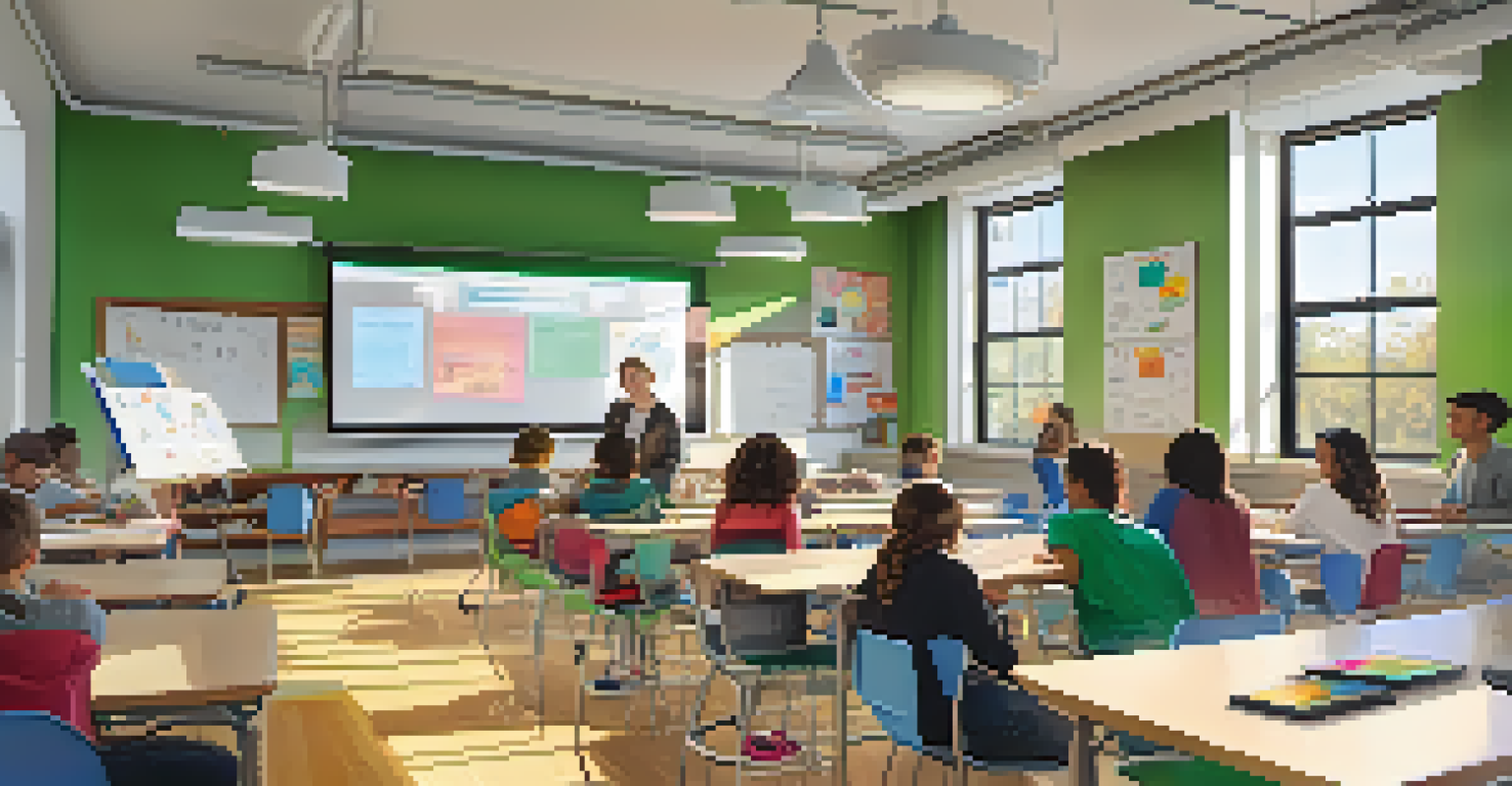Boston's Historic Schools: From Puritan Roots to Modern Times

The Puritan Beginnings of Education in Boston
Boston's education system has deep roots, tracing back to the early Puritan settlers in the 17th century. These settlers prioritized literacy and education, seeing it as essential to understanding the Bible and nurturing a moral society. The first public school, Boston Latin School, was established in 1635, marking the beginning of formal education in the city. This commitment to education laid the groundwork for a culture that values knowledge and learning.
Education is the most powerful weapon which you can use to change the world.
The Puritans believed that reading was vital not just for spiritual growth, but also for civic responsibility. This philosophy led to the establishment of schools in towns across New England, as communities recognized the need for educated citizens. As a result, Boston became a hub for educational innovation, setting a precedent for other colonies. The emphasis on education was seen as a way to uphold their religious and societal values.
Today, the legacy of these early educational practices can be seen in Boston's vibrant academic landscape. From prestigious universities to public schools, the city continues to honor its commitment to education. The foundations laid by the Puritans have evolved, but the spirit of learning remains strong in Boston's schools.
The Rise of Public Education in the 19th Century
As Boston grew during the 19th century, so did its education system, adapting to the needs of a diverse and expanding population. The Common School Movement emerged, advocating for free and accessible education for all children, regardless of their background. This movement was instrumental in establishing a public school system that reflected the democratic ideals of the time, ensuring that education was not just for the privileged few.

In 1821, the Boston School Committee was formed, leading to the establishment of a more organized public education system. Schools began to focus on a standardized curriculum, which included subjects like reading, writing, and arithmetic. This shift was significant in promoting equal opportunities for education, fostering a sense of community and citizenship among students. Boston's schools were seen as a vital part of the social fabric, promoting values of equality and democracy.
Puritan Roots of Boston Education
Boston's education system began in the 17th century with the Puritans, who emphasized literacy for spiritual and civic purposes.
By the end of the 19th century, Boston's public school system had gained national recognition for its progressive approach to education. Despite challenges, such as overcrowding and funding issues, the city remained committed to providing quality education. This era laid the groundwork for the modern educational system, influencing teaching methods and policies that are still relevant today.
The Role of Immigrants in Shaping Boston's Schools
As waves of immigrants arrived in Boston throughout the late 19th and early 20th centuries, they brought diverse cultures and languages that enriched the city's educational landscape. Schools became places where students not only learned academic subjects but also shared their unique backgrounds and traditions. The integration of immigrant populations highlighted the importance of inclusivity and multicultural education in Boston's schools.
An investment in knowledge pays the best interest.
Boston's educators faced the challenge of addressing the needs of students from various linguistic and cultural backgrounds. Bilingual education programs began to emerge, allowing non-English speakers to learn in their native languages while also acquiring English skills. This approach not only helped students succeed academically but also fostered a sense of belonging and community within the schools.
Today, Boston's schools continue to embrace diversity, reflecting the city's multicultural identity. Programs that celebrate cultural heritage and promote understanding among students are vital in creating a harmonious learning environment. The contributions of immigrant families have left an indelible mark on Boston's educational system, shaping it into a dynamic and inclusive space.
The Impact of the Civil Rights Movement on Education
The Civil Rights Movement of the 1960s had a profound impact on education in Boston, as it did across the United States. Efforts to desegregate schools led to significant changes in Boston's educational landscape, challenging long-standing inequalities. The landmark court case, Morgan v. Hennigan, mandated busing to integrate schools, igniting both support and opposition within the community.
The busing crisis in the 1970s exposed deep-seated racial tensions and disparities in the education system. Despite the challenges, the movement highlighted the need for equitable access to quality education for all students. Activists, parents, and educators rallied together to advocate for change, ensuring that the rights of marginalized students were recognized and upheld.
19th Century Public Education Growth
The Common School Movement in the 19th century established free public education, promoting equality and access for all children.
Today, the legacy of the Civil Rights Movement continues to influence Boston's schools. Efforts to promote equity and inclusion remain at the forefront, as educators strive to create environments where every student feels valued and supported. The struggles of the past serve as a reminder of the ongoing work needed to achieve true educational equality.
Innovations in Education: Boston's Modern Approach
In recent years, Boston has emerged as a leader in educational innovation, embracing new teaching methods and technologies. The city has seen a rise in charter schools, which offer alternative educational models aimed at improving student outcomes. These schools often focus on personalized learning, allowing students to progress at their own pace and explore their interests more deeply.
Moreover, Boston's schools have integrated technology into the classroom, enhancing the learning experience for students. Digital tools and online resources have become essential for fostering engagement and collaboration among students. This modern approach not only prepares students for the workforce but also equips them with critical thinking and problem-solving skills needed in today's world.
The emphasis on innovation in education reflects Boston's commitment to continuous improvement and adaptation. By prioritizing creative solutions to educational challenges, the city aims to provide its students with the best possible learning environment. Boston's schools are not just preparing students for exams; they are preparing them for life.
The Role of Higher Education in Boston's Growth
Boston is home to some of the most prestigious universities and colleges in the world, making it a center for higher education and research. Institutions like Harvard, MIT, and Boston University contribute significantly to the city's economy and cultural vibrancy. The presence of these universities has created a unique synergy between higher education and the local community, fostering innovation and collaboration.
Higher education in Boston has also played a crucial role in shaping the workforce, attracting talent from around the globe. The city's institutions offer a diverse range of programs that cater to various fields, from engineering to the arts. This educational ecosystem not only benefits students but also drives economic growth and development in the region.
Challenges and Innovations Today
Boston's education system faces challenges like funding disparities, but innovative programs and community efforts seek to enhance equity and quality.
Additionally, Boston's commitment to research and innovation has led to groundbreaking discoveries and advancements in various fields. The collaboration between universities and local industries has resulted in a thriving startup culture, positioning Boston as a leader in technology and entrepreneurship. The impact of higher education on Boston's growth is undeniable, shaping the city's future for generations to come.
Challenges and Opportunities in Boston's Education System
Despite its rich history and commitment to education, Boston's school system faces several challenges today. Issues such as funding disparities, overcrowded classrooms, and the need for equitable resources persist. These challenges can hinder the ability of schools to provide quality education, particularly in underserved communities, highlighting the ongoing struggle for educational equity.
However, with challenges come opportunities for growth and improvement. Community organizations, educators, and policymakers are increasingly collaborating to address these issues, advocating for policies that prioritize funding and resources for all schools. Innovative programs and initiatives are being developed to support students and teachers, ensuring that everyone has access to a quality education.

The future of Boston's education system hinges on the collective efforts of the community to confront these challenges head-on. By working together, Boston can continue to build on its historic legacy of education, creating a brighter future for all its students. The commitment to overcoming obstacles reflects the city's enduring belief in the power of education to transform lives.